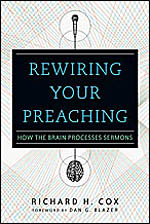Book Review: Rewiring Your Preaching: How the Brain Processes Sermons by Richard H. Cox
Richard H. Cox, Rewiring Your Preaching: How the Brain Processes Sermons
(Downers Grove, IL: InterVarsity Press, 2012) 181pp/$14.24

Richard Cox gives us a valuable resource for the craft of preaching. His volume is not so much about how to preach as more about what happens when we preach and how the brain processes external stimuli. Cox is an MDIV and a professionally trained psychologist, tapping the fields of neurobiology and neuroscience to share with preachers the awareness of the role of the brain for holistic healing–mind, body, spirit–with the unique role of preaching. Because the brain and the internal psyche are key to actions and emotions, it is key that preachers engage in intentional preaching, knowing what the goal is of a particular sermon, delivering it, and embracing the distinctive place that preaching has in people’s expectation every time the people of God gather that what is being proclaimed is, “thus saith the Lord.”
Because the brain “needs repetition, simplicity, and consistency” to build neural pathways to prior pieces of information and experiences that have been processed or stored in the memory for later use, this process of “engramming” (borrowed from Piaget’s writings) requires an intentionality of sermon preparation and delivery that will enable the brain to receive the message of the Word, build upon what is known, reframing the old to the new, assimilating or accommodating insights for further consideration, reflection, and action. Engramming, unlike branding or imprinting, comes from the inside to the outside, enabling us to understand spiritual, intellectual, emotional, and psychological development and maturity by aiming for the spoken and embodied word to penetrate into the heart, mind, and soul. One way this is done is through sermon series, lectionary preaching, the use of tangible objects during preaching, or intentionally directing the collective memory of the gathered community to previously spoken words as a way to assist the brain in making connections. Cox is careful to point out that the Holy Spirit is the One who uses these various modes of communication that the Church has been given in order to engram lives to bring healing and hope.
Gateways to the brain’s salutary effects involve community and the preacher. In terms of community, the Church should employ the full array of symbols and rituals of the faith, such as the sacraments, prayer, laying on of hands, incense, stained glass, the cross, the font, the Table. These enable the brain to receive messages of the faith, and anchors one’s life to the breadth of the community of faith. Religare, from which the word “religion” comes, means to reconnect and bind oneself back to your goal or origin. The foundational building blocks of the faith apprehended through symbols and rituals enable us to know whose we are and from whence we came.
In terms of the preacher, good preaching requires good pastoring, and vice versa. The credibility of the preacher is built upon when congregants know they are understood and cared for. Pastoral care enables the preacher to bring the spoken word to the holy parts of people’s lives and to acquaint herself with the stuff of life. Preaching is that unique moment when pastor and parishioner come together to hear a Word of healing and hope from God for the community through the preacher.
Preaching is a central aspect of the Church’s kerygmatic, prophetic calling. The Church, in its own life and in its witness in the world, has a responsibility to live out what Cox describes as the ethos, ethic, and ethics of what is proclaimed at the pulpit; what is at stake is “our being, our intent, and our action,” or the Church’s unique identity. The Church is not a mere social service agency with philanthropic causes. The Church continually becomes rooted in the Gospel in word and in deed, whenever the people of God gather to hear and receive the spoken Word, and whenever the people of God enact that Word in the world.
The gift of Cox’s book is in describing for us why preaching is efficacious and how our mind and our bodies receive and recognize preaching. Because what our brains receive on any given day influences what we do, what we feel, what we think, how we relate to others, to God, and to the world; the greatest value of this volume is to awaken us to that which we sometimes take for granted and that we need to be continually reminded of (which this book reinforces): preaching matters and needs more prominence in the Church’s life and witness.


